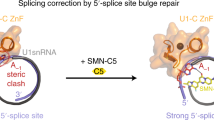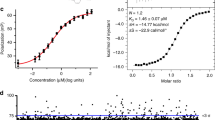Abstract
Arginine dimethylation plays critical roles in the assembly of ribonucleoprotein complexes in pre-mRNA splicing and piRNA pathways. We report solution structures of SMN and SPF30 Tudor domains bound to symmetric and asymmetric dimethylated arginine (DMA) that is inherent in the RNP complexes. An aromatic cage in the Tudor domain mediates dimethylarginine recognition by electrostatic stabilization through cation-π interactions. Distinct from extended Tudor domains, dimethylarginine binding by the SMN and SPF30 Tudor domains is independent of proximal residues in the ligand. Yet, enhanced micromolar affinities are obtained by external cooperativity when multiple methylation marks are presented in arginine- and glycine-rich peptide ligands. A hydrogen bond network in the SMN Tudor domain, including Glu134 and a tyrosine hydroxyl of the aromatic cage, enhances cation-π interactions and is impaired by a mutation causing an E134K substitution associated with spinal muscular atrophy. Our structural analysis enables the design of an optimized binding pocket and the prediction of DMA binding properties of Tudor domains.
This is a preview of subscription content, access via your institution
Access options
Subscribe to this journal
Receive 12 print issues and online access
$189.00 per year
only $15.75 per issue
Buy this article
- Purchase on Springer Link
- Instant access to full article PDF
Prices may be subject to local taxes which are calculated during checkout



Similar content being viewed by others
References
Bedford, M.T. & Clarke, S.G. Protein arginine methylation in mammals: who, what, and why. Mol. Cell 33, 1–13 (2009).
Siomi, M.C., Mannen, T. & Siomi, H. How does the royal family of Tudor rule the PIWI-interacting RNA pathway? Genes Dev. 24, 636–646 (2010).
Boisvert, F.M., Cote, J., Boulanger, M.C. & Richard, S. A proteomic analysis of arginine-methylated protein complexes. Mol. Cell. Proteomics 2, 1319–1330 (2003).
Brahms, H., Meheus, L., de Brabandere, V., Fischer, U. & Luhrmann, R. Symmetrical dimethylation of arginine residues in spliceosomal Sm protein B/B′ and the Sm-like protein LSm4, and their interaction with the SMN protein. RNA 7, 1531–1542 (2001).
Friesen, W.J., Massenet, S., Paushkin, S., Wyce, A. & Dreyfuss, G. SMN, the product of the spinal muscular atrophy gene, binds preferentially to dimethylarginine-containing protein targets. Mol. Cell 7, 1111–1117 (2001).
Côté, J. & Richard, S. Tudor domains bind symmetrical dimethylated arginines. J. Biol. Chem. 280, 28476–28483 (2005).
Friberg, A., Corsini, L., Mourao, A. & Sattler, M. Structure and ligand binding of the extended Tudor domain of D. melanogaster Tudor-SN. J. Mol. Biol. 387, 921–934 (2009).
Bühler, D., Raker, V., Lührmann, R. & Fischer, U. Essential role for the Tudor domain of SMN in spliceosomal U snRNP assembly: implications for spinal muscular atrophy. Hum. Mol. Genet. 8, 2351–2357 (1999).
Pellizzoni, L., Kataoka, N., Charroux, B. & Dreyfuss, G. A novel function for SMN, the spinal muscular atrophy disease gene product, in pre-mRNA splicing. Cell 95, 615–624 (1998).
Pellizzoni, L., Yong, J. & Dreyfuss, G. Essential role for the SMN complex in the specificity of snRNP assembly. Science 298, 1775–1779 (2002).
Meister, G. et al. SMNrp is an essential pre-mRNA splicing factor required for the formation of the mature spliceosome. EMBO J. 20, 2304–2314 (2001).
Rappsilber, J., Ajuh, P., Lamond, A.I. & Mann, M. SPF30 is an essential human splicing factor required for assembly of the U4/U5/U6 tri-small nuclear ribonucleoprotein into the spliceosome. J. Biol. Chem. 276, 31142–31150 (2001).
Paushkin, S., Gubitz, A.K., Massenet, S. & Dreyfuss, G. The SMN complex, an assemblyosome of ribonucleoproteins. Curr. Opin. Cell Biol. 14, 305–312 (2002).
Meister, G. & Fischer, U. Assisted RNP assembly: SMN and PRMT5 complexes cooperate in the formation of spliceosomal UsnRNPs. EMBO J. 21, 5853–5863 (2002).
Selenko, P. et al. SMN Tudor domain structure and its interaction with the Sm proteins. Nat. Struct. Biol. 8, 27–31 (2001).
Sprangers, R., Groves, M.R., Sinning, I. & Sattler, M. High-resolution X-ray and NMR structures of the SMN Tudor domain: conformational variation in the binding site for symmetrically dimethylated arginine residues. J. Mol. Biol. 327, 507–520 (2003).
Hebert, M.D., Shpargel, K.B., Ospina, J.K., Tucker, K.E. & Matera, A.G. Coilin methylation regulates nuclear body formation. Dev. Cell 3, 329–337 (2002).
Renvoisé, B. et al. Distinct domains of the spinal muscular atrophy protein SMN are required for targeting to Cajal bodies in mammalian cells. J. Cell Sci. 119, 680–692 (2006).
Vagin, V.V. et al. Proteomic analysis of murine Piwi proteins reveals a role for arginine methylation in specifying interaction with Tudor family members. Genes Dev. 23, 1749–1762 (2009).
Kirino, Y. et al. Arginine methylation of Piwi proteins catalysed by dPRMT5 is required for Ago3 and Aub stability. Nat. Cell Biol. 11, 652–658 (2009).
Nishida, K.M. et al. Functional involvement of Tudor and dPRMT5 in the piRNA processing pathway in Drosophila germlines. EMBO J. 28, 3820–3831 (2009).
Liu, H. et al. Structural basis for methylarginine-dependent recognition of Aubergine by Tudor. Genes Dev. 24, 1876–1881 (2010).
Liu, K. et al. Structural basis for recognition of arginine methylated Piwi proteins by the extended Tudor domain. Proc. Natl. Acad. Sci. USA 107, 18398–18403 (2010).
Botuyan, M.V. et al. Structural basis for the methylation state–specific recognition of histone H4–K20 by 53BP1 and Crb2 in DNA repair. Cell 127, 1361–1373 (2006).
Huang, Y., Fang, J., Bedford, M.T., Zhang, Y. & Xu, R.M. Recognition of histone H3 lysine-4 methylation by the double Tudor domain of JMJD2A. Science 312, 748–751 (2006).
Taverna, S.D., Li, H., Ruthenburg, A.J., Allis, C.D. & Patel, D.J. How chromatin-binding modules interpret histone modifications: lessons from professional pocket pickers. Nat. Struct. Mol. Biol. 14, 1025–1040 (2007).
Mecozzi, S., West, A.P. Jr. & Dougherty, D.A. Cation-π interactions in aromatics of biological and medicinal interest: electrostatic potential surfaces as a useful qualitative guide. Proc. Natl. Acad. Sci. USA 93, 10566–10571 (1996).
Gallivan, J.P. & Dougherty, D.A. Cation-π interactions in structural biology. Proc. Natl. Acad. Sci. USA 96, 9459–9464 (1999).
Chen, C. et al. Mouse Piwi interactome identifies binding mechanism of Tdrkh Tudor domain to arginine methylated Miwi. Proc. Natl. Acad. Sci. USA 106, 20336–20341 (2009).
Chari, A., Paknia, E. & Fischer, U. The role of RNP biogenesis in spinal muscular atrophy. Curr. Opin. Cell Biol. 21, 387–393 (2009).
Pellizzoni, L., Charroux, B. & Dreyfuss, G. SMN mutants of spinal muscular atrophy patients are defective in binding to snRNP proteins. Proc. Natl. Acad. Sci. USA 96, 11167–11172 (1999).
Eggert, C., Chari, A., Laggerbauer, B. & Fischer, U. Spinal muscular atrophy: the RNP connection. Trends Mol. Med. 12, 113–121 (2006).
Raker, V.A., Plessel, G. & Lührmann, R. The snRNP core assembly pathway: identification of stable core protein heteromeric complexes and an snRNP subcore particle in vitro. EMBO J. 15, 2256–2269 (1996).
Chari, A. et al. An assembly chaperone collaborates with the SMN complex to generate spliceosomal SnRNPs. Cell 135, 497–509 (2008).
Zhang, R. et al. Structure of a key intermediate of the SMN complex reveals gemin2′s crucial function in snRNP assembly. Cell 146, 384–395 (2011).
Friesen, W.J. et al. The methylosome, a 20S complex containing JBP1 and pICln, produces dimethylarginine-modified Sm proteins. Mol. Cell. Biol. 21, 8289–8300 (2001).
Kessler, H. Detection of hindered rotation and inversion by NMR spectroscopy. Angew. Chem. Int. Ed. Engl. 9, 219–235 (1970).
Cheng, D., Cote, J., Shaaban, S. & Bedford, M.T. The arginine methyltransferase CARM1 regulates the coupling of transcription and mRNA processing. Mol. Cell 25, 71–83 (2007).
Sims, R.J. et al. The C-terminal domain of RNA polymerase IIiIs modified by site-specific methylation. Science 332, 99–103 (2011).
Kirino, Y. et al. Arginine methylation of Vasa protein is conserved across phyla. J. Biol. Chem. 285, 8148–8154 (2010).
Delaglio, F. et al. NMRPipe: a multidimensional spectral processing system based on UNIX pipes. J. Biomol. NMR 6, 277–293 (1995).
Sattler, M., Schleucher, J.R. & Griesinger, C. Heteronuclear multidimensional NMR experiments for the structure determination of proteins in solution employing pulsed field gradients. Prog. Nucl. Magn. Reson. Spectrosc. 34, 93–158 (1999).
Breeze, A.L. Isotope-filtered NMR methods for the study of biomolecular structure and interactions. Prog. Nucl. Magn. Reson. Spectrosc. 36, 323–372 (2000).
Neri, D., Szyperski, T., Otting, G., Senn, H. & Wuthrich, K. Stereospecific nuclear magnetic resonance assignments of the methyl groups of valine and leucine in the DNA-binding domain of the 434 repressor by biosynthetically directed fractional 13C labeling. Biochemistry 28, 7510–7516 (1989).
Grzesiek, S. & Bax, A. A three-dimensional NMR experiment with improved sensitivity for carbonyl-carbonyl J correlation in proteins. J. Biomol. NMR 9, 207–211 (1997).
Hu, J.S. & Bax, A. χ1 angle information from a simple two-dimensional NMR experiment that identifies trans 3JNCγ couplings in isotopically enriched proteins. J. Biomol. NMR 9, 323–328 (1997).
Güntert, P. Automated structure determination from NMR spectra. Eur. Biophys. J. 38, 129–143 (2009).
Shen, Y., Delaglio, F., Cornilescu, G. & Bax, A. TALOS+: a hybrid method for predicting protein backbone torsion angles from NMR chemical shifts. J. Biomol. NMR 44, 213–223 (2009).
Linge, J.P., Williams, M.A., Spronk, C.A., Bonvin, A.M. & Nilges, M. Refinement of protein structures in explicit solvent. Proteins 50, 496–506 (2003).
Brünger, A.T. et al. Crystallography & NMR system: a new software suite for macromolecular structure determination. Acta Crystallogr. D Biol. Crystallogr. 54, 905–921 (1998).
Schüttelkopf, A.W. & van Aalten, D.M. PRODRG: a tool for high-throughput crystallography of protein-ligand complexes. Acta Crystallogr. D Biol. Crystallogr. 60, 1355–1363 (2004).
Kleywegt, G.J. Crystallographic refinement of ligand complexes. Acta Crystallogr. D Biol. Crystallogr. 63, 94–100 (2007).
Becke, A. Density-functional thermochemistry. III. the role of exact exchange. J. Chem. Phys. 98, 5648–5652 (1993).
Lee, C., Yang, W. & Parr, R.G. Development of the Colle-Salvetti correlation-energy formula into a functional of the electron density. Phys. Rev. B Condens. Matter. 37, 785–789 (1988).
Gill, S.J. Thermodynamics of ligand-binding to proteins. Pure Appl. Chem. 61, 1009–1020 (1989).
Capaldi, S. et al. The X-ray structure of zebrafish (Danio rerio) ileal bile acid-binding protein reveals the presence of binding sites on the surface of the protein molecule. J. Mol. Biol. 385, 99–116 (2009).
Press, W., Teukolsky, S., Vetterling, W. & Flannery, B. Numerical Recipes 3rd Edition: The Art of Scientific Computing (Cambridge University Press, 2007).
Acknowledgements
The authors are grateful to G. Demiraslan (Helmholtz Zentrum München) for protein production. We thank I. Poser and T. Hyman (Max Planck Institute of Molecular Cell Biology and Genetics) for the gift of the SMN-GFP stable cell line, J. Brennecke for helpful discussion and the Bavarian NMR Centre for NMR time. K.T. acknowledges support by the Alexander von Humboldt foundation; T.M. acknowledges support by a European Molecular Biology Organization Long Term Fellowship and a Schrödinger Fellowship from the Austrian Science Fund. This work was supported by the Deutsche Forschungsgemeinschaft (M.S. and K.M.N.).
Author information
Authors and Affiliations
Contributions
K.T. carried out molecular biology experiments, protein purification, NMR analysis and structure calculations. T.M. did quantum chemical calculations and contributed to NMR experiments. D.F. analyzed the ITC experiments. K.M.N. and U.F. designed, and M.M. and C.E. conducted, immunoprecipitation experiments. K.T. and M.S. conceived and designed the project and wrote the paper. All authors discussed the results and commented on the manuscript.
Corresponding author
Ethics declarations
Competing interests
The authors declare no competing financial interests.
Supplementary information
Supplementary Text and Figures
Supplementary Figures 1–13 and Supplementary Tables 1 and 2 (PDF 10421 kb)
Rights and permissions
About this article
Cite this article
Tripsianes, K., Madl, T., Machyna, M. et al. Structural basis for dimethylarginine recognition by the Tudor domains of human SMN and SPF30 proteins. Nat Struct Mol Biol 18, 1414–1420 (2011). https://doi.org/10.1038/nsmb.2185
Received:
Accepted:
Published:
Issue Date:
DOI: https://doi.org/10.1038/nsmb.2185
This article is cited by
-
The coilin N-terminus mediates multivalent interactions between coilin and Nopp140 to form and maintain Cajal bodies
Nature Communications (2022)
-
A small molecule antagonist of SMN disrupts the interaction between SMN and RNAP II
Nature Communications (2022)
-
The MuvB complex binds and stabilizes nucleosomes downstream of the transcription start site of cell-cycle dependent genes
Nature Communications (2022)
-
The protein arginine methyltransferase PRMT9 attenuates MAVS activation through arginine methylation
Nature Communications (2022)
-
The phospho-landscape of the survival of motoneuron protein (SMN) protein: relevance for spinal muscular atrophy (SMA)
Cellular and Molecular Life Sciences (2022)



